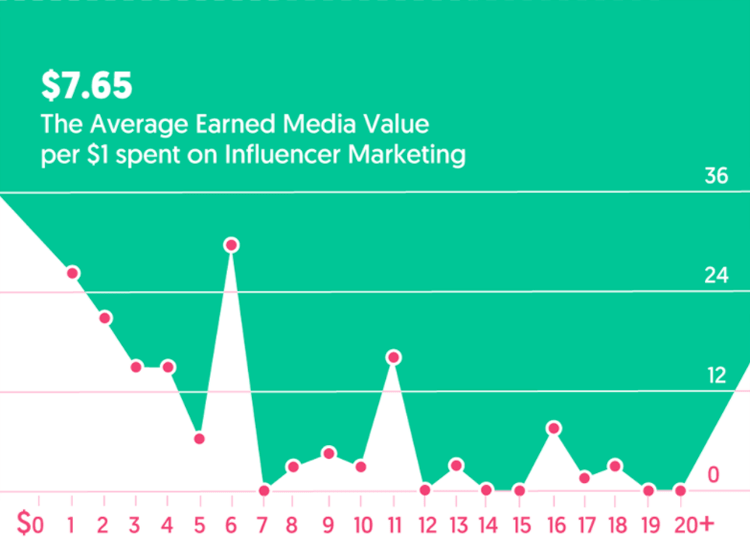Social media approval is now one of the smartest ways to drive sales while increasing your customer base. By leveraging the eminence of an influencer’s reputation it’s possible that you can save yourself, and your business, much more than money.
However, starting an influencer marketing strategy is not always as simple as it may at first appear. Apart from being aware of the importance of influencer marketing, there is still the process and the required results to be determined. If you want to use this strategy to its full potential, getting it right is a must, otherwise, you may be doing your business more harm than good.
Influencer marketing is becoming an increasingly popular marketing strategy in the world of modern business. In fact, 89 percent of marketing professionals are of the opinion that ROI obtained through influencer marketing is equal to, if not more effective than other marketing strategies. In fact, influencer marketing has been seen to deliver up to 11X more ROI than comparable marketing channels. According to a recent survey by Influencer Marketing Hub, on average, businesses earn $7.65 for every $1 they spend on influencer marketing. Moreover, based on the survey on eCommerce trends, 75% of online retailers said that they used influencers in their marketing campaigns in 2021.

However, it’s worth remembering that influencer marketing strategies have changed dramatically since the outbreak of COVID-19. While influencers can still make significant income from YouTube, Instagram, Tik Tok, and other social media platforms, the market has shifted as businesses have become accustomed to the current economic climate. In this article, we will show you how to start an influencer marketing strategy while considering the impact of COVID-19. Maintaining and growing social proof on channels such as Facebook and Instagram is now more important than ever before.
Whether you already have an influencer marketing strategy, or not, these helpful steps can get you up and running in no time. So let’s get started!
1. Get the current picture
The first step towards building a viable influencer marketing strategy is fact-finding and proper analysis of the current market conditions. As a brand, you may need a marketing team or marketing manager to make the right information and metrics available.
The information includes a review of current consumer behavior, leading innovations, and the overall impact of external social forces.
For instance, recent trends show that buyers have gradually adjusted to the economic impact of COVID-19. Consequently, total advertising - cum marketing spend - by top brands is projected to fall by a massive 8.1%, which equals $49.6bn.
However, even while considering the current COVID-19 pandemic situation brands are still using influencer marketing to connect with people while creating a feeling of well-being. Customers may have lower purchasing power right now, but it is unlikely that they will forget brands that addressed their immediate needs during one of the world’s most severe and disruptive pandemics.
2. Define your target market
After you’ve decided to create an Influencer marketing strategy you must also define your audience.
Your audience is a particular cohort of people to whom your products best appeal. The mistake of many businesses is that they target their products and services at a wide and general audience.
Despite the initial desire to cast your seeds far and wide, it is imperative that you ensure you focus on the right people. Bad marketing is synonymous with targeting the wrong product to the wrong audience.
According to the Pareto principle, 80% of your marketing success will come from 20% of your marketing efforts. As such, to maximize efforts and convert sales you will need to:
- Discover your best customers
- Determine their geographic location
- Discover their interests and what appeals to them
- Know the right time to target them
- Know the best social media platforms to reach them
Although some forms of influencer marketing are conducted across all social platforms, not every platform is guaranteed to work for your particular business model. If you’re selling skincare products and you have identified that your target audience can be found on Instagram, it’s probably best to use that platform in order to reach them directly. Here’s more on skincare product marketing.
3. Find the right influencers
Presenting the wrong influencers to your target audience is akin to having a vehicle with flat tyres, you won’t get very far until you remedy the situation. Making sure the influencer soothes your brand’s objective is essential to the success of this strategy.
The right influencer must be someone your particular audience admires, trusts, and respects. Interestingly, 71% of influencers believe a person with an honest voice will create magic every time.
A 2016 Twitter research shows that 40% of users made direct purchases due to influencer-based marketing. Twitter, therefore, concluded that most users trust influencers as much as they trust their friends. In a nutshell, this means that you should target the right influencers, not just the popular ones.
There are many individuals across many platforms who constantly proclaim themselves to be messiahs of influence. But are they?
Here’s a helpful guide to help you find the best influencers to suit your particular needs:
- Relevance: Influencer marketing is simply about using the leverage of the right person to reach a target audience. Ask yourself if the influencer, and their audience, are the perfect partners for your brand.
- Reach: An influencer’s number of followers is an essential metric in the process of boosting your brand’s awareness. Obviously, the greater the number of followers the bigger their influence is. However, it is essential to find out whether these followers are active or merely fluff.
- Engagement: Influencer marketing is also about ensuring these audiences are actively participating in the content which you present. A good influencer can call his audience to action when needed, thus helping ensure that you achieve the required results.
You are now ready to begin your search for the right influencer.
One simple way to begin the process is by going through your contact list. You might be pleasantly surprised to find that the person, or persons, you are looking for might have been right in front of you all the time. Who are your contacts and who are they following might be all you need to ask.
Another method is, to begin with, a Google search - if you know the right question to ask. Such is the power of influencer marketing that over the past year the term itself - ‘influencer marketing’ - has increased by a massive 325% in Google searches.
You can also conduct a search using tools like Buzzsumo, Awario, etc.
4. Take advantage of micro-influencers
With the impact of COVID-19 and the increasing costs of hiring an influencer marketer, micro-influencers are becoming ever more popular.
Micro-Influencers are popular bloggers, vloggers, or social media authorities who cater to a specific niche. Usually, they don’t have a particularly high number of followers, but what they do have is the ability to generate greater engagement through the content they provide.
Interestingly, there is an inverse relationship between an increased number of followers and the average number of engagements with content. The more followers an influencer tends to generate the greater their engagement diminishes on that particular platform.
Micro-Influencers are far easier to deal with and are significantly more effective in driving direct sales. Considering the level of active participation in their content, Micro-influencers are the ideal solution when it comes to a specific call to action.
5. Reach out to influencers
Finding the right influencer is one thing, convincing them to work with you is another. To impress an influencer you will need to sound convincing and come armed with a well prepared and well-presented pitch
Brands can reach out to influencers through a personal message on their social media platforms, or through a direct and customised email. Stating what you are willing to pay is important, but knowing you don’t always have to do this is equally important.
Instead of monetary payment you also have the option of offering your influencers free products in return for shout-outs or brand endorsements. Of course, it is also possible to simply pay for these shout-outs.

6. Craft your campaign
Companies clearly see influencer marketing as a direction in which they wish to travel - especially during these uncertain times. According to a recent survey by Influence Marketing Hub, two-thirds of respondents plan to increase their influencer marketing budget, while only 4% of firms have decided to move away from the strategy.
Influencer marketing is about creating great marketing campaigns in tandem with others. Working out a plan for your campaign helps you identify the preferred platforms on which to showcase the campaign, while also ensuring it conforms to the brand’s goal.
In recent years Instagram has evolved and its stature has grown exponentially to become one of the most widely used social media platforms. The figures behind Instagram success are simply phenomenal - over 1 billion people use Instagram every month; 500 million people use Instagram stories on a daily basis; 200 million Instagram users visit a business profile every day; the list goes on and on. These are the sort of metrics that go towards proving the importance of using Instagram advertising as a means of growing your business.
Who creates the posts for your influencer? You can give influencers free rein to give shout-outs on a post which you have made or one which they have made themselves. Either way, this can prove quite effective as the post will be exposed across the influencer’s entire audience.
Another smart tactic is to ask the influencer to change their Instagram bio link to your product page. This means that anyone who views their bio will be exposed to your product through a direct link - one of the best ways to monitor results with real-time metrics.
Having multiple influencers acting in a similar fashion can increase your brand awareness exponentially.
7. Monitor campaigns
Here’s one last thing to keep in mind when you are about to engage in an Influencer marketing strategy. Some of the most effective goals which you set for yourself should include the following:
- increasing brand awareness;
- reaching new/target audiences;
- improving brand advocacy;
- directly increasing sales.
Once you have the campaign goals set and in place you need to identify the metrics which will be used to measure them.
Your performance metrics could include:
- the number of impressions;
- clicks;
- brand mentions;
- follower growth;
- increase in brand engagement;
- revenue;
- user-generated content.
Whichever you use make sure that they are measurable and you are suitably prepared to take the relative actions.
Conclusion
Tapping into the rich benefits of Influencer marketing might be just what your business needs. With this particular strategy, your brand can double its sales while achieving high visibility on multiple social media platforms. Isn’t that what every business wants?
Now that you’ve seen the steps you need to take to create an influencer marketing strategy, what are you waiting for? Remember, you don’t need to have all the money in the world in order to make great campaigns.




